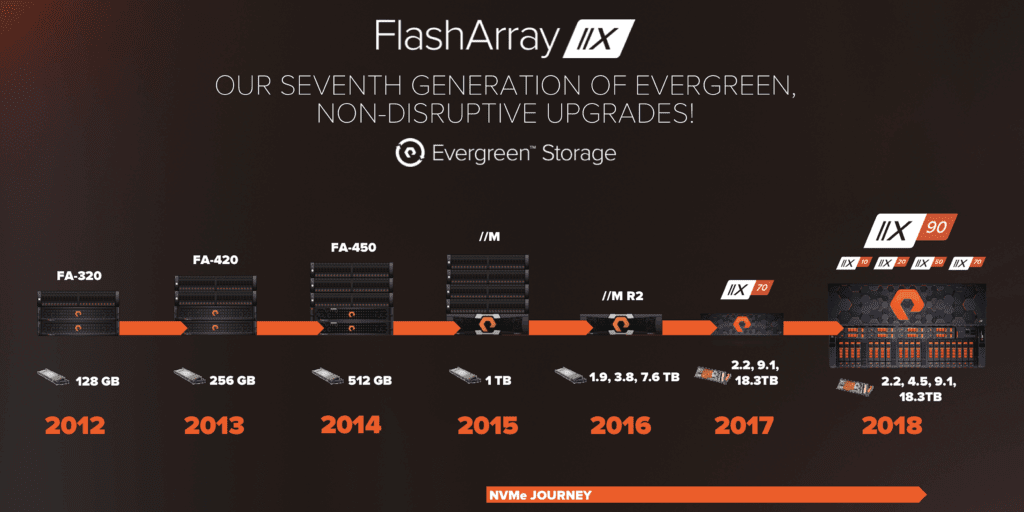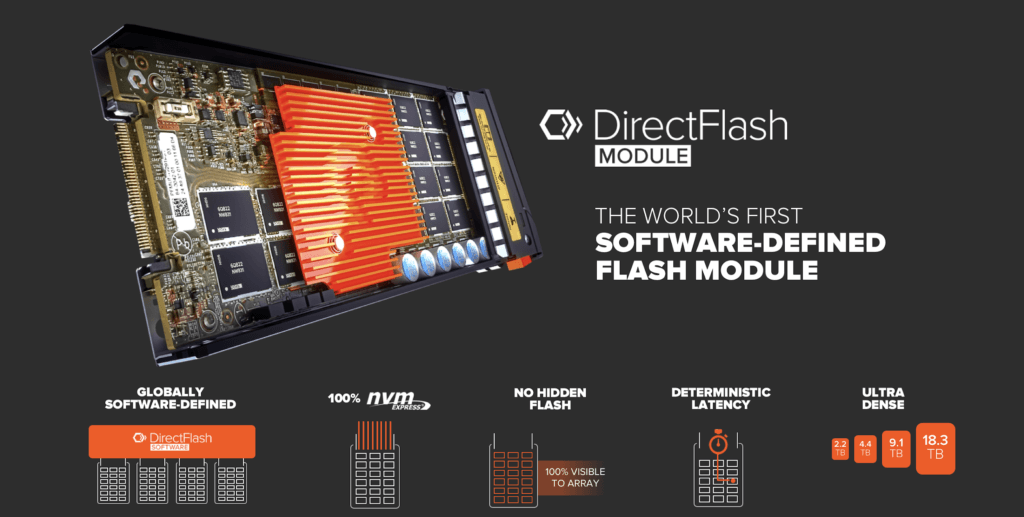Non-Volatile Memory Express (NVMe) is becoming the primary protocol for interconnecting modern storage technologies both within storage arrays and between storage arrays, storage networks, and servers. Unlike the legacy storage interconnections of the past, NVMe was designed specifically for solid-state storage technologies in a high-performance parallel vs. serial world. The NVM Express Organization that oversees the standards for NVMe describes their role:
“NVM Express is a non-profit industry organization developing an open collection of standards and information designed to fully expose the benefits of non-volatile memory in all types of computing environments from mobile to data center. The NVMe™ specification is designed from the ground up to deliver high bandwidth and low latency storage access for current and future NVM technologies.
NVMe was formed to remove the bottlenecks in legacy storage infrastructure designed for hard drives, with a streamlined protocol, scalable performance, and industry standard software and drivers.”
Pure Storage made a major strategic commitment to NVMe starting with our FlashArray//M family of products in 2015. We’re now on our fourth-generation of NVMe with our newest FlashArray//X family, and the dramatic performance, density, and consolidation benefits of DirectFlash™ with NVMe over legacy storage technologies have been providing customers with enormous value.

There are various places in the storage infrastructure where NVMe can play, and in different ways. Pure’s use of NVMe began first with moving data through NVRAM cache over PCIe with NVMe protocol on FlashArray//M, expanded next into the data path over PCIe with NVMe to our DirectFlash Modules on FlashArray//X70, and then from our chassis to our expansion shelves using NVMe-oF (NVMe over fabric) over 50gb Ethernet with our latest FlashArray//X family.
We expect that the next horizon for the industry will be NVMe-oF from the front end of all-flash storage arrays into storage networks and servers across both Ethernet and Fibre Channel. The benefits of NVMe-oF include faster connectivity between storage and servers as well as more efficient CPU usage. This will enable further consolidation in the data center of apps that traditionally rely on Direct Attached Storage (DAS), which will be able to run on shared networked storage, given faster network speed, broader bandwidth. The term Gartner has coined for this approach is Shared Accelerated Storage. Here’s an analyst view of the NVMe-oF potential now that the NVMe standard for Fibre Channel (FC-NVMe) has been defined and released. Some vendors have already introduced initial NVMe-oF products ahead of the standards, and so the race is on!
The Competitive Landscape for All-Flash Arrays and NVMe … according to Dell
In 2018, many storage vendors have also realized that NVMe is a “must have” technology in the All-Flash-Array (AFA) storage market going forward, as Dell EMC, NetApp, HPE-Nimble, and IBM have all either announced and started delivering products that use NVMe, or have stated their intentions to do so.
Just this past May 2018, Dell EMC announced their first significant venture into NVMe technology with Dell’s new PowerMax systems. Our initial reaction to the PowerMax announcement is in this blog.
In a recent FAQ document about Dell’s PowerMax system, Dell published a chart presenting Dell’s view of the NVMe storage competitive landscape as determined by the “VMAX Technical Competitive Analysis Team”. It can be found under What is the competitive landscape for NVMe? about one-third of the way into the document. Since Pure Storage is specifically mentioned in this Dell FAQ document, we would like to share our views on Dell’s positioning of our product.
Dell gives both Pure Storage and Dell’s PowerMax a “Yes” in the categories of “NVMe NAND backend” and “NVMe cache”. Broadly speaking, we agree that both systems support this, although there are differences in how they are implemented. Pure uses our software-defined NVMe DirectFlashTM Modules (described below) to store data on FlashArray, while Dell’s PowerMax uses conventional dual-ported NVMe SSDs.

Since Pure’s FlashArray was architected to always use nothing but solid-state media for back-end data storage, our NVRAM cache is for writes-only, and unnecessary for reads that are always delivered at flash speed over NVMe. Dell’s PowerMax still uses a legacy cache architecture that evolved from the original first Symmetrix system (1990), which caches all reads and all writes in DRAM cache, since it was designed to assume that the back-end would be slow conventional mechanical disk drives. To deliver optimal performance on that kind of architecture, there is a lot of performance-oriented intelligence that has evolved over decades and is built into the software for PowerMax to try to determine what data to bring into cache, when to bring it there, and how long to keep it there. Although that kind of intelligence certainly added great value for EMC’s conventional storage systems and hybrid storage systems in the past, at Pure we have found that for our all-flash FlashArray such an approach is simply unnecessary. As discussed in one of my previous blogs, you might want to ask Dell what value it actually delivers today in the current all-flash PowerMax.
Dell promotes PowerMax as ready for storage class memory (SCM) – or “SCM ready”, much like Pure did with “NVMe ready” several years ago. For the category “NVMe SCM backend” Dell gives themselves a “Yes” and gives Pure a “No”. Dell puts in a note that by “Yes” for the PowerMax what they specifically mean is that it is expected to be available in “Q1 FY’20”. So Dell is claiming an advantage on a capability that is not available today, and that in Dell’s own words will be added as soon as “technically feasible” and will carry a price premium of “around 5-10X per GB compared to NVMe NAND drives.” We are fine with a “No” for this category for FlashArray, as we have not yet announced any specific products, prices, or availability for SCM technology as it continues to evolve. At Pure we believe that we’ll only deserve a “Yes” if and when we announce and ship a customer-consumable product for mainstream adoption – and as for SCM storage, neither Pure nor Dell has done that yet for these products.

On this same chart, similarly you might want to ask yourself if you believe that Dell’s claim of “Q1 FY’20” merits the “Yes” that they give themselves for NVMeF (NVMe-oF) for PowerMax. And although Pure does already use NVMe-oF on FlashArray today to communicate between the primary chassis and optional additional storage shelves (over 50 gb Ethernet), and we are flattered that Dell has chosen to give Pure a “Yes” for that category, from some perspectives we might not yet quite deserve a “Yes” there. We think that what our customers really mean and want when they look at NVMe-oF is front-end connectivity from the storage array to their servers, usually over a storage network. As mentioned in this blog, we plan to introduce NVMe-oF to FlashArray for front-end connectivity for both Ethernet and Fibre Channel, with our initial offering with RoCE over Ethernet as early as late 2018. So while technically FlashArray does use NVMe-oF today and PowerMax does not, there is much more to come!

Curiously, despite all of the attention that Dell gives to NVMe with the new PowerMax, the benchmarks behind both the IOPS and Bandwidth performance results that Dell has released publicly so far do not actually use or touch the new NVMe back-end of the PowerMax at all. And the one performance expectation that Dell has released for PowerMax that does use the NVMe infrastructure on PowerMax – a claim of up to 50% better latency – was run with SCM drives that Dell has stated will not be available until FY’20. You can read about all of that in detail in this blog.
Since the date of this Dell competitive chart, two of the other vendors mentioned in the chart have also released NVMe technology on new flash storage platforms that were not available at the time. So in our opinion, if this Dell competitive chart were to be updated to reflect the accurate state of things right now in October, 2018, those two vendors should see some of those Dell-assigned ratings of “No” change to “Yes”, while the status for Dell’s PowerMax would remain unchanged. At Pure, we would expect that any vendor that expects to succeed in the modern world of solid-state storage arrays going forward will be supporting NVMe.
What’s Ahead? – Innovation, or Struggle?
Adjacent to Dell’s competitive landscape chart in this document is some verbiage that we think warrants some discussion: “Pure is also in a strong position but without a scale out architecture (a very hard thing to retro-fit), they will struggle to really leverage the power of NVMe and next gen drive architectures.”
We humbly thank Dell for stating that Pure is in a strong position. As for our choice of a scale-up stateless architecture with FlashArray (vs. a scale-out architecture), we respectfully disagree that our architecture hinders us in any way from leveraging NVMe now or in the future. We would suggest asking Dell what specifically they think Pure would possibly struggle with relative to NVMe, and why? You might want to also ask what it is about either scale-up or scale-out that architecturally has anything at all to do with NVMe?
Pure designed our architecture intentionally with the knowledge of what customers told us they didn’t like about their existing alternative legacy storage architectures – things like wanting to avoid painful data migrations and forklift upgrades both within and between sprawling product portfolios; eliminating complex installation and operations; not wanting a myriad of software licenses; and eliminating constant performance management and tuning.
Pure has already delivered a “next-gen drive architecture” with our innovative DirectFlash Module as a concrete-example of providing a more modern and practical approach for solid state media, available for both our FlashBlade and FlashArray families of products. Here’s a video that provides some of the initial background into why Pure moved on from conventional SSDs and moved up to DirectFlash.

The earliest generations of FlashArray did use NAND SSDs in conventional legacy disk drive physical formats – as does PowerMax now. But the massively greater parallelism offered by NVMe allows for a much more modern and practical format better-suited for flash that leaves the legacy disk-drive model behind. By creating our own custom modules using NVMe and the same commodity flash and protocols found in conventional flash drives, we are able to improve space efficiency, power, performance, price, capacity density, and flexibility.
Specifically, our largest current NVMe DirectFlash module supports 18.3TB, while the largest NVMe SSD supported by PowerMax is 7.68TB. This is only one of the factors that explains why when comparing FlashArray and PowerMax at comparable effective capacities that FlashArray requires much less physical space, much less power, and much less cooling. One of the other key reasons is superior data reduction efficiency.
We are flattered that some other vendors (not Dell) have also introduced this type of “next gen” approach by building their own flash modules instead of just using conventional SSDs in some of their all-flash arrays, so clearly others also recognize the value of innovation beyond the legacy disk form factor.

In summary, FlashArray has consistently proven that our architecture can seamlessly embrace and adapt to the newest technological innovations – even doing so with non-disruptive upgrades that don’t impact performance, with data-in-place, eliminating the need for data migrations. And whether it’s SCM or something else that feeds the “next gen”, at Pure we see no limitations to our architecture embracing any suitable future technologies. And we believe that for all the right reasons, NVMe will be an integral part of our technology future, without obstacles. Please contact us to learn more about how our NVMe-powered solutions can help you, with solutions both today AND for the future!







